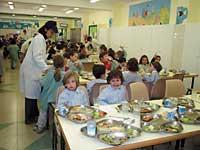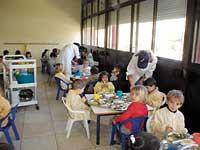How can we make food at home?

Each school chooses the way to cook. Some prepare it at the school itself; others, once prepared abroad, transport it with vehicles to school, where they maintain the temperature of food with hot tables. For their part, a few schools have opted for organic foods and, in addition to cooking in the school itself, choose organic foods. In both choice and food preparation, the economic cost is important.
Meals in the dining rooms are currently supervised by a dietitian or expert and parents are informed of the menu throughout the month. But many ignore this information, even if it is very valuable and useful. What is it for? The answer is clear: adapt and complement the child's diet. And it is that we should prepare the evening dinner considering who has eaten in the dining room.

The food needs of children are very high, since on the one hand they are growing and on the other, they are very active at that age. Never leave in the hands of the dining room all responsibility for the good food of the child, since the food is only a meal and the child does all the others at home. The meal should contain between 35 and 40% of all the energy that the child needs throughout the day, while dinner should complete the meals of the day. For example, if you haven't eaten the whole day, that's the time.
No one doubts that a good meal has to have three dishes: the first, the second and the dessert to finish. Dinner also needs the same structure. The first course should be a source of vitamins,
fibers and mineral salts. The second, on the other hand, must offer the growing child the necessary proteins. Finally, the dessert must complete the dinner. Therefore, although many times we start with the second dish for simplicity, we must not forget that before the child has to eat others.
On the other hand, there are some dishes that children like very much: pizza, burgers, st jacobos, etc. They can eat from time to time, but do not become everyday dishes. However, there is a big difference between the two. For example, at home you can make healthy pizzas, with less fat than those outside; for this, on the basis, in addition to tomato and cheese, we can put zucchini, eggplant, mushrooms, tuna, prawns, pineapple, etc.

It is recommended to change the menu of the dining room according to the seasons to encourage the consumption of the products offered by each season. In addition, in spring and summer you can put cold dishes, such as salads and cold creams, while in autumn and winter you can apply warmer to combat the cold. On the other hand, it is not always advisable to give a very chopped meal (purees, burgers...), except in very young children. The child should learn to eat foods of different textures.
The dining option has other advantages: bad children eat much better with others, and it can be a good opportunity to learn to eat; in addition, the fact that there are more and more students from other countries makes the dining room can learn the eating habits of other countries.
Obese in childhood, obese in maturity
Acquiring proper feeding habits in childhood, in addition to being necessary to achieve proper physical and psychological development, is a way to avoid future problems. It seems that the number of obese children is growing considerably and experts are quite concerned about the consequences this may have.

If young children are potolos they are much more attractive, but we must take care of them carefully so that the child's food is adequate. In childhood adipocytes or fat cells are produced. Therefore, if many addivenites occur, the child will have more facility to fatten in the future. That is why it is said that the child who is fatter in childhood will have much more chances of being obese in the future. If before age seven begins with obesity problems, the probability of being fat at maturity is 41%, while if obese in adolescence is 80%.
Therefore, we must try to meet the needs of the child. To do this we must always take into account the speed of growth, since the speed is not the same for all ages, we must also choose food well, that is, discard foods rich in energy but with little nutrients, especially sweets and extrusion foods (worms, potatoes).





